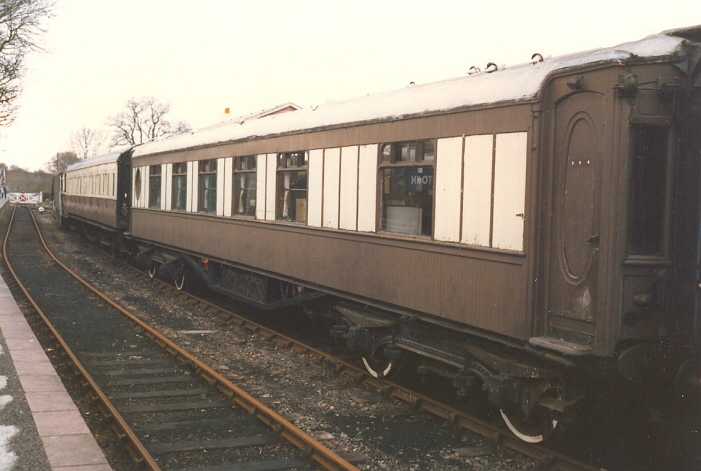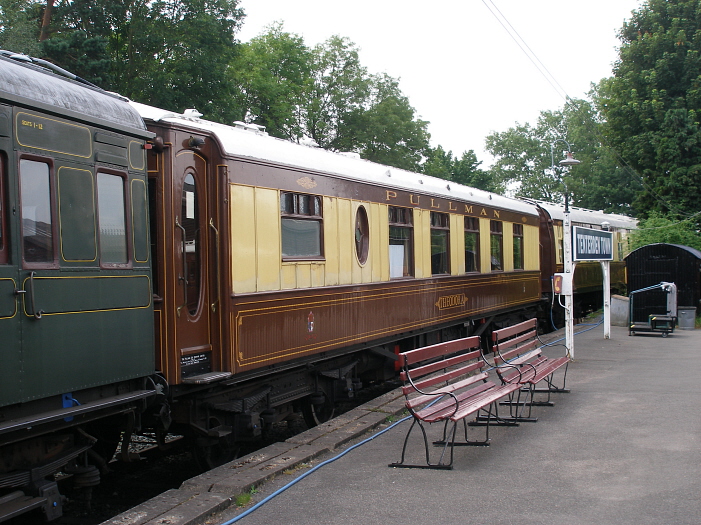
Theodora
Pullman Kitchen Car
In 1925, the Southern Railway ordered six narrow-bodied Pullman carriages from the Pullman Car Company. All vehicles of this batch were First Class Kitchen cars, and were destined for the Hastings route via Tunbridge Wells Central, a line well known for its narrow tunnels and restrictive clearances. Construction was subcontracted to the Metropolitan Cammell Carriage, Wagon & Finance Company of Birmingham, but production of the elaborate internal marquetry and decoration was the responsibility of Messrs A. Dunn & Son of Chelmsford, Essex. All vehicles of this batch were completed in January 1926.
Barbara: First Class Kitchen Car (Schedule No. 185)
Camilla: First Class Kitchen Car (Schedule No. 180)
Latona: First Class Kitchen Car (Schedule No. 181)
Madeline: First Class Kitchen Car (Schedule No. 182)
Pomona: First Class Kitchen Car (Schedule No. 183)
Theodora: First Class Kitchen Car (Schedule No. 184)
Notes: All cars were fitted with twenty seats
At
8-foot 1-inch wide, these were the narrowest Pullman cars ever to be built, most
vehicles at the time being 8-foot 7-inches in width. The carriage bodies were
fabricated from timber throughout, sat upon a steel chassis, and externally
demonstrated a distinctive ‘’matchbox’’ finish of vertical wooden strips. The
latter was not unique to the ‘’Hastings’’ batch of carriages, but many Pullman
cars later lost this patterning, when the wooden strips were plated over with
steel. ‘’Theodora’’, as indeed her five counterparts, was intended to operate as
a standalone First Class vehicle amongst standard SR coaching stock. With
reference to the latter, these were designed by R.E.L. Maunsell and were fitted
with Pullman-style gangway connections, buckeye couplings, and featured flat
sides (as per the Pullman cars they worked with) to fit within the gauge
restriction of the Hastings route. After six and a half years of active service,
all six ‘’Hastings’’ Pullmans were temporarily withdrawn from service and
dispatched to Preston Park Works, Brighton for internal remodelling. The
carriages re-emerged during July 1932 as composite vehicles, with overall
capacity increased as a result of degrading part of the accommodation to Third
Class. Twelve First Class and eleven Third Class passengers could now be seated,
at additional supplements to the main ticket price of 2 shillings and 1 shilling
respectively.
The outbreak of war on 3rd September 1939 saw the withdrawal of all Pullman
vehicles from SR services. Those cars within the ‘’5-BEL’’ and ‘’6-PUL’’ units
on the Central Section were granted a temporary reprieve between 1940 and 1942,
but no Pullman vehicles were seen in services thereafter until after the end of
the conflict. World War II marked the end of Theodora’s association with the
SR’s Eastern Section. In 1946, the carriage was dispatched to Preston Park
Works, again for internal remodelling, where it reverted to an all-First Class
vehicle. The name ‘’Theodora’’ was dispensed with, and the car was simply
designated by its original schedule number 184 thereafter. ‘’No. 184’’ was
redeployed on the SR’s Western Section, where it was used on Ocean Liner
Expresses between Waterloo and Southampton Docks, formed amongst standard SR
coaching stock. In July 1958, ‘’No. 184’’ arrived, for the last time, at Preston
Park, for yet another internal remodelling exercise to be undertaken. The
carriage was converted into a Kitchen Bar Car, and was painted all-over in
standard SR green, losing all traces of its Pullman branding. The carriage
formally became the property of BR’s Southern Region on 5th November 1960, and
consequently, was renumbered into the standard coaching series as No. S7874S.
No. S7874S was withdrawn from service in December 1963, and was earmarked
dispatch to South Wales for scrapping. It was rescued in September of the
following year by the K&ESR Preservation Society and, with sister Pullman No.
S7877S (formerly ‘’Barbara’’), was taken by rail to Tenterden Town station, via
Robertsbridge, for preservation. No. S7874S initially served as a refreshment
car at Rolvenden, being re-painted into Umber and Crème colours, but was later
moved back to Tenterden Town for use as a static buffet vehicle. It was
superseded in this role by a purpose-built refreshment room in 1986, and was
again moved to Rolvenden, where it was stored out of use. A full restoration
effort on the carriage finally began in 2003, after funds from the Government’s
Millennium Commission were secured. Overhaul of ‘’Theodora’’ was completed in
February 2005, and the vehicle joined the ‘’Wealden Pullman’’ service in the
following month.
Additional Notes [Theodora: As Built]
Tare (Empty Weight): 39 tons (down to 38 tons from 1946 onwards)
Length: 57-foot 1½-inches
Width: 8-foot 1-inch
No. of Seats: 20
Bogies: Pullman Standard
Route Availability (SR): 0 (Unrestricted)
Construction: Timber body upon a steel chassis
Other: Based at Tenterden, Kent & East Sussex Railway
March 1987

The ''match box'' finish is seen to good effect in this 1987 view of ''Theodora''. It had yet to be restored and was
seen stabled in the run-a-round loop at Tenterden Town, outside of the operating season. Mike Glasspool
26th July 2008

''Theodora'' is seen stabled in the dedicated ''Wealden Pullman'' siding at Tenterden Town. Although the crème
paintwork has now faded in places, this remains an attractive vehicle, and is an appropriate item of stock for
the line, having formerly been used on the nearby ''Hastings'' route through Robertsbridge. David Glasspool
Return to the Kent Rail Homepage or alternatively, check for Updates.
Website & Copyright information - Links - Contact the Webmaster
All content is copyright © David Glasspool unless otherwise stated